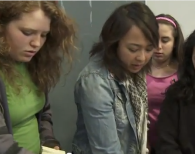By Janet Sasson Edgette, Psy.D
Sharing the quiet neighborhood in which I grew up was a girl I’ll call Marcie. Marcie wasn’t a particularly nice girl, but that didn’t stop me or any of the other kids in the neighborhood from trying to be her friend. She toyed sadistically and expertly with our wishes to be part of her “in” group.
One summer she made each of us pinkie swear that we believed her story about there being the decapitated Frankenstein heads underneath the sewer lids on our street. I didn’t believe in Frankenstein, but I was afraid to not believe in Marcie. I spent one whole year engrossed in the terrible, tantalizing fantasy of lifting off those lids and finding heads in varying states of decay.
middle school

Palo Alto High interviews younger brother Noah Hornikat It Gets Indie last year. Photo Courtesy of Julian Hornik.
When Julian Hornik was cyber-bullied for being gay, he didn’t have to worry about having anything but the full support from his family.
In middle school, the young musician found derogatory comments on YouTube videos of his performances. Classmates created a Facebook page that targeted him for being gay. With the support of his family, he said it wasn’t hard for him to “push it away.”
Julian and his younger brother Noah are part of an extended family of people who support LGBT rights. While Noah has not personally experienced bullying, he believes the internet allows people to feel “safer and more confident” when they bully and harass others.
“They don’t have to see the impact,” Noah said. “People will go a lot farther.”

On the Day of Silence, we share with you the story of one middle school that provided the space for all of its students to have their voices heard.
"Forming a Gay Straight Alliance at a middle school requires courage—for the administrator to step up, for the teacher who serves as the advisor, and for each student who walks through that door to be a member."
By Dr. Becki Cohn-Vargas, Not In Our School Director
My daughter knew she was gay from when she was a young girl, but it wasn’t until middle school that she told me. Not all young people have someone to talk to at that sensitive age.
At Hoover Middle School in the San Francisco Unified School District, teacher Janet Miller learned frightening statistics about her district’s Lesbian, Gay, Transgender, and Questioning (LGBTQ) students at a district training. She discovered that transgender youth were the most likely students to attempt suicide. Impassioned, Janet explains that she got on a table and shouted to the staff, "It’s our job and the job of every single person in this room to enforce safety for all students, not just straight ones, so any time you are not doing it, you are not doing your job!” She convinced the staff that Hoover needed to do something about this serious issue.

In the aftermath of a hate crime, how do teachers open a conversation with their students about hate and intolerance? After seven high schoolstudents assaulted and killed Ecuadorean immigrant Marcelo Lucero in Patchogue, NY, local educators were shocked that this could happen intheir town. At South Ocean Middle School, Principal Linda Pickford wantedto create a safe environment where her students could express theirfeelings about the tragedy, and share their ideas about diversity,immigration, inclusion and respect.
When Patchogue Mayor Paul Pontieri suggested that Principal Pickfordhost an art exhibit called “Embracing Our Differences,” she agreed thatart was a great medium to explore these important issues, and shemounted the collection of banners on the front lawn of her school.
